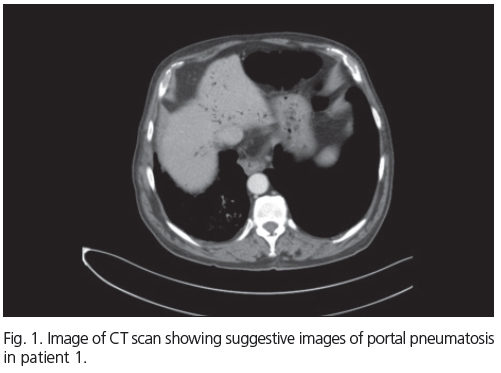Mi SciELO
Servicios Personalizados
Revista
Articulo
Indicadores
-
 Citado por SciELO
Citado por SciELO -
 Accesos
Accesos
Links relacionados
-
 Citado por Google
Citado por Google -
 Similares en
SciELO
Similares en
SciELO -
 Similares en Google
Similares en Google
Compartir
Revista Española de Enfermedades Digestivas
versión impresa ISSN 1130-0108
Rev. esp. enferm. dig. vol.105 no.5 Madrid may./jun. 2013
https://dx.doi.org/10.4321/S1130-01082013000500016
LETTERS TO THE EDITOR
Portal pneumatosis: Sign of alert or casual discovery?
Neumatosis portal: ¿signo de alerta o hallazgo casual?
Key words: Portal neumatosis. Intestinal ischemia. Portal gas.
Dear Editor,
The presence of gas in the portal system is a rare radiological sign, known as portal pneumatosis related to bowel ischemia and a fatal outcome (1). However, there are other causes such as inflammatory bowel disease, infectious, interventional procedures, trauma, etc, that justify this finding with better prognosis (2,3).
Case reports
Case report 1. The first is a 77-year-old male with atrial fibrillation and chronic obstructive airway disease, presented with a history of periumbilical pain of sudden onset and diarrhea. Initial assessment revealed afebrile, soft abdomen, mild abdominal pain in epigastric region without signs of peritoneal irritation, and 18,000/mmc leukocytes. In ultrasound-CT (Fig. 1), linear multiple images are observed distributed peripherally in relation to intrahepatic gas associated with thickening of the bowel wall, with no free liquid. With the diagnosis of acute gastroenteritis and because of the clinical stability, absence of pathological exploration and suspected inflammatory process, it was decided hospitalization for medical treatment. The patient evolved satisfactorily.
Case report 2. The second case is a 64-year-old male with hypertension, presented with a seven-day history of mesogastric pain, vomiting and diarrhea. Hemodynamically stable, the abdomen is globular, diffusely painful, with discrete peritoneal reaction. Laboratory tests demonstrate leukocytosis (13,700/mmc). A CT revealed the presence of portal gas and dilated jejunum with intestinal pneumatosis suggestive of ischemia. Given these findings, we decided emergency surgery, where we explore all the small and large intestine. The only finding was a thin segment slightly dilated but without signs of ischemia deciding to end the intervention. Subsequently, the outcome was satisfactory.
Discussion
The portal neumatosis is due to different etiologies, such as ischemic disease and other intestinal inflammatory-infectious processes, trauma, after endoscopic procedures (3-5), etc. Classically, the presence of gas in the portal system associated with intestinal ischemia is suspected, was indicative of high mortality rate, being imperative urgent (6) surgery.
There are predisposing factors (3) for the emergence of this sign such as the escape of gas produced by microorganisms in the intestinal lumen and abscesses, or its presence in the portal venous system.
Continuous advances in imaging techniques have allowed an increase in sensitivity in the diagnosis of these findings, even though they are incipient (7,8).
In view of the cases presented, we confirm the presence of portal pneumatosis in situations outside the intestinal ischemia, which presented good prognosis. Likewise, we consider justified the laparotomy in the second patient, since, as several authors maintain (9,10), it is essential, at the slightest suspicion, to rule out serious clinical processes.
We conclude that the fundamental is framing the neumatosis portal in the particular clinical context of each patient, discarding the most serious processes, which lead to high mortality and require an urgent surgical treatment.
José Felipe Reoyo-Pascual, Raquel León-Miranda, Xandra Valero-Cerrato,
Rosa M.a Martínez-Castro, Adel Eldabe-Mikhail and Juan Luis Seco-Gil
Service of General and Digestive Surgery. Hospital Universitario de Burgos. Burgos, Spain
References
1. Susman N, Senturia HR. Gas embolization of the portal venous system. AJR Am J Roentgenol 1960;83:847-50. [ Links ]
2. Mancebo A, Álvarez-Hornia E, Rodriguez-Peláez M, Ibáñez M, Luyando LM, Varela M. Indolent evolution of an episode of acute gastroenteritis complicated with portal pneumatosis. Rev Esp Enferm Dig 2010; 102:557-9. [ Links ]
3. Abboud B, El Hachem J, Yazbeck T, Doumit C. Hepatic portal venous gas: Physiopathology, etiology, prognosis and treatment. World J Gastroenterol 2009;15:3585-90. [ Links ]
4. Kinoshita H, Shinozak M, Tanimura H, Umemoto Y, Sakaguchi S, Takifuji K, et al. Clinical features and management of hepatic portal venous gas. Four case reports and cumulative review of the literature. Arch Surg 2001;136:1410-4. [ Links ]
5. Magrach LA, Martín E, Sancha A, García M, Cendoya I, Olabarria I, et al. Gas venoso portal intrahepático. Significado clínico y revisión de la bibliografía. Cir Esp 2006;79(2):78-82. [ Links ]
6. Liebman PR, Patten MT, Manny J, Benfield JR, Hechtman HB. Hepatic-portal venous gas in adults: Etiology, pathophysiology and clinical significance. Ann Surg 1978;187(3):281-7. [ Links ]
7. Monneuse O, Pilleul F, Barth X, Gruner L, Allaouchiche B, Valette PJ, et al. Portal venous gas detected on computed tomography in emergency situations: surgery is still necessary. World J Surg 2007;33:1179-83. [ Links ]
8. Duron VP, Rutigliano S, Machan JT, Dupuy DE, Mazzaglia PJ. Computed tomographic diagnosis of pneumatosis intestinalis: clinical measures predictive of the need for surgical intervention. Arch Surg 2011;146:506-10. [ Links ]
9. Pastor C, A.-Cienfuegos J, Bueno A, Pedano N, Martinez P, Baixauli J. Réplica: significado clínico de la neumatosis portal. Rev Esp Enferm Dig 2011;103:107-8. [ Links ]
10. Morris MS, Gee AC, Cho SD, Limbaugh K, Underwood S, Ham B, et al. Management and outcome of pneumatosis intestinalis. Am J Surg 2008;195:679-83. [ Links ]















